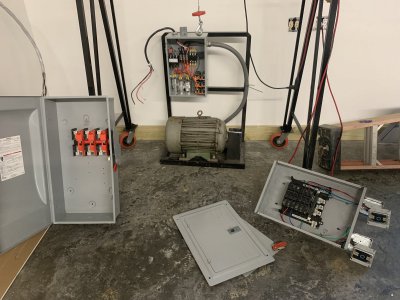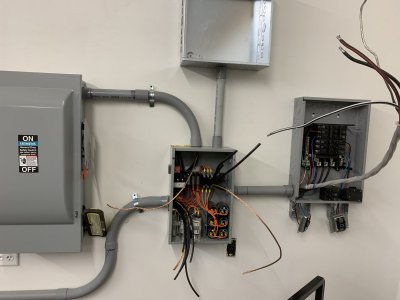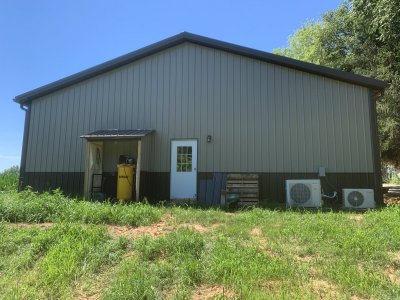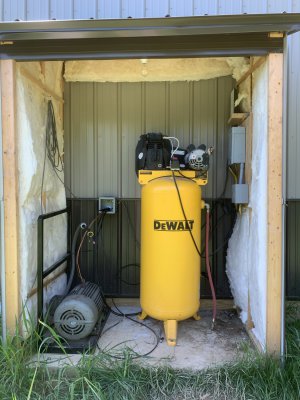-
Welcome back Guest! Did you know you can mentor other members here at H-M? If not, please check out our Relaunch of Hobby Machinist Mentoring Program!
You are using an out of date browser. It may not display this or other websites correctly.
You should upgrade or use an alternative browser.
You should upgrade or use an alternative browser.
New shop! (was: Multiple buildings, ...)
- Thread starter rabler
- Start date
- Joined
- Feb 25, 2021
- Messages
- 3,129
I calculated 7200 lbs based on it's size and the typical weight of granite. I threw out a lowball offer on a nearby ebay listing and it was accepted. I remember they tried to pick it up with a 5000lb capacity forklift, I just chuckled. It was a CMM table, and has threaded inserts embedded about .030 below the surface on some sort of regular pattern. I don't think that'll matter for what I do.Randall , what does that surface plate weigh in at , just for curiosity's sake ?
- Joined
- Feb 25, 2021
- Messages
- 3,129
Which means that the office will have to be Lilliput (the land of small things), and the normal working area will be Laputa (the land of science and art that produces nothing useful), and the front welding area will be Houyhnhnm, where the yahoos work.I'm thinking of naming that corner of the shop "Brobdingnag"
- Joined
- Sep 2, 2021
- Messages
- 156
I don't know about rabler, but I had fun! It was nice to be around big equipment again. There was some paint damage but nothing more, thankfully. Really heavy stuff can do unexpected things, kinda like operating a 50T press. That telehandler was boss, and every feature was used. RA didn't mention (it's kinda hard to see in pic #8 and #10- dup?) that we pushed the big lathe all the way across the shop lengthwise with just the boom extending because the rest of the machine was such a tight fit. Still had about 20' of boom left! I teased him about having all hooked up and running clean by the time I got home (an hour), but he was too tired to appreciate the satire! I still can't believe what he gets done by himself and with friend wife's help.
DanK
DanK
- Joined
- Feb 25, 2021
- Messages
- 3,129
Thanks again Dan. Appreciated your help. To bad we didn't have time to do some playing with that thing. Maybe see if it would push over trees?I don't know about rabler, but I had fun! It was nice to be around big equipment again. There was some paint damage but nothing more, thankfully. Really heavy stuff can do unexpected things, kinda like operating a 50T press. That telehandler was boss, and every feature was used. RA didn't mention (it's kinda hard to see in pic #8 and #10- dup?) that we pushed the big lathe all the way across the shop lengthwise with just the boom extending because the rest of the machine was such a tight fit. Still had about 20' of boom left! I teased him about having all hooked up and running clean by the time I got home (an hour), but he was too tired to appreciate the satire! I still can't believe what he gets done by himself and with friend wife's help.
DanK
Still haven't gotten everything hooked up though!
We got the last six or so sheets of drywall up now that the mini-splits are in, joints taped, and primed.
The mill and lathe need to be set down on leveling pads, rather than the misc pieces of 4x4 they are now resting on. And I have to get the RPC set up. I decided to take the WNY panel and rebuild it, I'm going to make a 2 stage RPC, and am toying with a microcontroller design to switch in balancing caps as needed. I'll rebuild it into a 2 stage manual version first with off-on-auto switches so I have something usable while toying with that. Next month I'll need to order steel for the crane legs, after I get those in I can move the smaller mill and lathe into their section of the shop.
- Joined
- Feb 25, 2021
- Messages
- 3,129
Getting the compressor installed, and the RPC idler, in the small build-out blister on what I think of as the back side of the shop (although it is the side that faces the road though hidden by brush grown-up through the fence line. The compressor is powered through a contactor on the interior light switch, so I don't have to remember to turn it on/off. Got the electrical details all finished yesterday. The insulation is strictly for noise damping. I have air lines (PEX) run around the inside of the shop. Through the wall is copper. Still need to install shut offs, drain taps, filters, and quick connect outlets. At some point I may try adding a cooler/radiator between the pump and tank, but for now there are too many to-dos.


The RPC needs to be assembled. I originally had the control panel mounted on the black frame that holds the 20HP idler. I'm wiring it through the wall. The original panel on/off contactor buzzed like crazy, very annoying. I'm waiting on a replacement for that, although I ordered a larger contactor, and some other electrical parts, as I am setting up the RPC so that I can upgrade it to a 10+20HP in the future.
Still need to make panel doors for this extension.




The RPC needs to be assembled. I originally had the control panel mounted on the black frame that holds the 20HP idler. I'm wiring it through the wall. The original panel on/off contactor buzzed like crazy, very annoying. I'm waiting on a replacement for that, although I ordered a larger contactor, and some other electrical parts, as I am setting up the RPC so that I can upgrade it to a 10+20HP in the future.
Still need to make panel doors for this extension.


- Joined
- Feb 25, 2021
- Messages
- 3,129
The RPC peaked out at 209 amps starting current (peak capture on a Fluke 33 clamp-on amp-meter on the single phase lines). I'd like to get that down to around 1/2 that. I'm planning to try using a 10HP initial idler first, and if that doesn't get the current down I'll go with a pony motor. Technically our rural power co-op is not fond of large motors on residential lines, although they went with "it hasn't caused problems so far" when I upgraded to a 400A meter to put in this shop.
- Joined
- Nov 24, 2014
- Messages
- 3,164
Exciting (no pun intended) progress going on there.
I want to be sure I understand the implications of your RPC plans.
I think you bought a 20 HP RPC (panel + idler). Correct?
Now you're talking about using a 10 HP idler?
Is it OK to run a 10 HP idler from a 20 HP panel (as is) or do you have to change any components in the panel?
You say "10HP initial idler". Does that mean you start the 10 HP idler, then after it's up to speed, you switch in the 20 HP idler, or?
So do you run both idlers continuously or switch of the 10 HP idler once the 20 HP is up to speed?
I want to be sure I understand the implications of your RPC plans.
I think you bought a 20 HP RPC (panel + idler). Correct?
Now you're talking about using a 10 HP idler?
Is it OK to run a 10 HP idler from a 20 HP panel (as is) or do you have to change any components in the panel?
You say "10HP initial idler". Does that mean you start the 10 HP idler, then after it's up to speed, you switch in the 20 HP idler, or?
So do you run both idlers continuously or switch of the 10 HP idler once the 20 HP is up to speed?
Last edited:
- Joined
- Feb 25, 2021
- Messages
- 3,129
Ray,I want to be sure I understand the implications of your RPC plans.
I think you bought a 20 HP RPC (panel + idler). Correct?
Now you're talking about using a 10 HP idler?
Is it OK to run a 10 HP idler from a 20 HP panel (as is) or do you have to change any components in the panel?
You say "10HP initial idler". Does that mean you start the 10 HP idler, then after it's up to speed, you switch in the 20 HP idler, or?
So do you run both idlers continuously or switch of the 10 HP idler once the 20 HP is up to speed?
Going to give you the long explanation to the best of my knowledge (which isn't complete).
The current panel and idler are a 20HP setup. I'm *considering* rebuilding it into a RPC with BOTH a 10 HP idler and a 20HP idler, which could be run in 10, 20, or 10+20 modes, depending on need. Right now I do not need more than 20HP of RPC idler (10HP machines) but I am considering buying and rebuilding a CNC VMC, and some of those are a bit more power hungry.
The main components of an RPC are
1) An idler
2) Contactors - Typically one for on/off, and one for the start caps
3) run capacitors
4) start capacitors
5) some odds and ends
Usually there is an input contactor which turns the incoming single phase on/off. It needs to be sized to the input current. Actually, contactors are sized by maximum throughput current and maximum switching current, and of course voltage(s). The thoughput current is basically a matter of heating up (resistance) of the guts of the contactor, and the switching current is a matter of the contacts being able to handle arcing effects on opening/closing. Due to surge currents on starting motors, contactors sometimes also have a maximum HP rating. Anyhow, within reason, an oversize contactor will not be a problem. As the existing on/off contactor is buzzing annoyingly, I'm replacing it with a quality 95amp/30HP rated contactor.
The start capacitors are a bit of a ballpark guess for the motor HP. These capacitors are connected across briefly at startup by a contactor driven through a timer circuit. The actual capacitance can be a bit of a trade off on surge startup current vs spin-up time. This capacitance is achieved by paralleling several capacitors (6 in this case).
The run capacitors are ideally "tuned" based on voltage measurements under load. This tuning varies based on the load, and to a lesser extent the actual idler motor characteristics. Again this is achieved by parallel a bank of capacitors.
Due to electro-mechanical characteristics, run capacitors and start capacitors are not interchangeable. Basically run capacitors have a 100% duty cycle. Start capacitors have a much shorter duty cycle (due to heat buildup) but for the size and cost have significantly greater capacitance (1-2 orders of magnitude). Both types of capacitors need to be able withstand AC voltage, which is a problematic constraint in capacitor design.
But the gist of all of it is that the capacitors in a fixed design don't provide great voltage control across all three phases over a wide variety of loads. And a large idler running to drive a small load is not the most efficient approach.
Since I want to fix the annoying buzz, I'm redesigning my RPC panel to accommodate some future changes, but I haven't fully committed to those. What I'd like to do is use a microcontroller (Arduino, Teensy, etc) to monitor the voltages on all three phases. Potentially using FFT's to get both voltage and phase information. Maybe throw in some hall-effect current monitoring. I have some basic circuits in mind but prototyping is needed. Based on voltage measurements I could then dynamically have the microcontroller switch in/out additional capacitance (adding or subtracting from the number of capacitors actively connected in parallel) to get the best voltage match across all three phases, using either TRIACs or power MOSFETs rather than contactors.
When this came up before, having enough CPU throughput to handle FFTs in most microcontrollers has been raised as a question. Obviously it depends to some extend on which microcontroller. But the maximum sampling rate I need to do basic phase comparisons is pretty trivial. I'd probably shoot for 480Hz over a few cycles of 60Hz, so maybe a 16 pt FFT on each leg? Actual details TBD. But the whole thing is sort of a future project.
In addition to doing dynamic capacitance adjustments, I'd set up the microcontroller to handle transitions from off-10HP-20HP-30HP modes. Still have to have the operator (me) select the mode, as it takes too long to spin up another motor to do it dynamically based on load. Might be able to do some predictive guesses based on what machines where switched on, but I don't see that as feasible. Somewhere along the line a pony motor to start an idler is also a possibility?? Power factor correction on the incoming line is also a possibility.
So, for now, fix the contactor buzz, and remote the idler to outside rather than inside with the control panel. With wiring gauges sufficient for expanded capacity if I decide to pursue that.
Last edited:
- Joined
- Sep 2, 2021
- Messages
- 156
Randy, I'm not an ejuneer, but a dumb idea occurred to me. What if (hold my beer) you let the RPC's and a pony motor run continuously, perhaps on the same shaft and control their capacity continuously using electronic supervision. There would be no delay in "spin up time" and power required in the pony just to keep idle armatures spinning would be minimal. Another dumb alternative might be to find a 30 hp motor with multiple field windings that could be rearranged or engaged as needed making all three motors compact in one unit.
Jiggle, jiggle....put that in your pipe and smoke it! LOL! But you can';t let the smoke out because you know these things run on smoke and don't work if you let the smoke out.
DanK
Jiggle, jiggle....put that in your pipe and smoke it! LOL! But you can';t let the smoke out because you know these things run on smoke and don't work if you let the smoke out.
DanK

